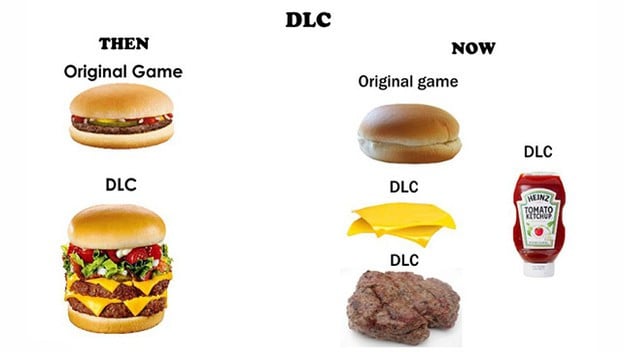Downloadable Content often brings mixed reactions from gamers. Some don’t care about it, some love how it extends the lives of games, and some get downright angry about it. No matter our feelings about it, however, the DLC-model has proven to be a profitable one for game developers and publishers alike. It’s definitely going nowhere any time soon, but the question is, where is it going from here?
On consoles, the Sega Dreamcast was the first console to employ DLC, because it was the first console to feature online support out of the box. However, at that time, most people were on dial-up or had really slow/bad “high speed connections” with DSL. Between that and the size limitations of the Dreamcast memory cards, DLC was rarely utilized.
It was the original Xbox that made DLC more mainstream. The Xbox Marketplace offered extra content for its games, which was mostly free. With the advent of the Xbox 360, DLC came in full circle. Microsoft was now able to integrate DLC more seamlessly with their console, and they encouraged their developers to create small pieces of extra content for $1-$5, as opposed to full game expansions. Microsoft saw DLC as a way for gamers to get more from their games and for devs/pubs to pocket a bit more money. It was a win-win for everyone involved, especially for Microsoft in the long run.
Alas, as what happens with most good ideas and good intentions, people muddied it up.
Activision and Harmonix both jumped on this idea with vigor, continually adding new songs for players to purchase for Guitar Hero and Rock Band . Activision also used DLC to extend the lives of their Call of Duty titles, offering map packs with 2-3 new maps for $15 a pop.
Many people were already getting irritated with how much DLC was releasing with each title, especially when DLC was announced before the game even went gold. Begrudged consumers accused developers of charging DLC for content that was supposed to be in the game originally. Others complained about consumers enabling the cycle by paying $15-20 for map packs and costumes.
It all came to head in 2012 when the first on-disc DLC was discovered. Mass Effect 3 and EA were the first offenders with on-disc DLC regarding a side mission and a new character for Shepard’s party. Both were on disc at launch, but only those who preordered the game or purchased the DLC afterward could unlock it. Around the same time, consumers discovered quite a bit of locked on-disc DLC for Street Fighter x Tekken .

The backlash was not pretty, and to be honest, it shouldn’t have been pretty. Nobody cared what EA and Capcom’s reasons were for the on-disc DLC. The point is that they shipped content already made that people couldn’t unlock without paying more money. It’s one thing to pay for additional content after launch, but it’s quite another to ship a game with this “additional” content.
Developers and publishers both seem to have settled down how DLC should be handled in the future. Even now, it’s rare to have a game announce DLC before game ships. Many games, such as Horizon: Zero Dawn and The Witcher 3 , didn’t announce any DLC until the games were on store shelves for about a year. And even then, those were more of expansion packs for the game instead of extraneous content.
Some publishers have opted for the Season Pass route, offering to sell all foreseeable DLC content at this one low price upfront. For avid Call of Duty players, this meant they knew they were getting every map pack available. For Mortal Kombat , players knew they could get all of the new characters without paying piecemeal down the road. And other Season Passes, like Assassin’s Creed Odyssey’s , offered full new missions released every week, plus expansions, plus costumes, plus in-game currency, etc.
This seems to be the sweet spot for DLC, as long as people—on both sides of the coin—don’t muddy it up again.
